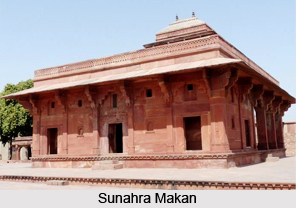 Sunahra Makan, so called because of the beautiful murals and gold coloured paintings that once adorned it, stands at the south-east of Panch Mahal as a severe looking building. It is now generally referred to as Maryam`s House. A pavilion on top softens the otherwise grim look of the building. Stone eaves (restored in 1925-26) run around the building and are supported on heavy brackets. Some of these are carved: one shows Lord Rama attended by Hanuman, another, a pair of fat geese, clearly mirroring Hindu imagery.
Sunahra Makan, so called because of the beautiful murals and gold coloured paintings that once adorned it, stands at the south-east of Panch Mahal as a severe looking building. It is now generally referred to as Maryam`s House. A pavilion on top softens the otherwise grim look of the building. Stone eaves (restored in 1925-26) run around the building and are supported on heavy brackets. Some of these are carved: one shows Lord Rama attended by Hanuman, another, a pair of fat geese, clearly mirroring Hindu imagery.
There were two Maryams in Akbar`s court: Maryam Makani (`equal in rank to Mary`) was Akbar`s mother, Hamida Banu Begum, and Maryam Zamani (`Mary of the Age`) was his first Rajput queen and mother of his first-born son, Emperor Jahangir. Since it is fairly certain that Maryam Zamani lived in the main palace of the Haram Sara, it may be safely presumed that Akbar`s mother, Maryam Makani lived in this building. While travelling with the emperor her importance was acknowledged by assigning her a central place in the camp.
North-west of Sunahra Makan is a small, secluded garden laid out on the charbagh principle. In the middle of this charming garden is a small fishpond. Going back towards the Hawa Mahal one would come across the screened arches of the Nagina Mosque. All Mughal palaces have a small private mosque set aside for the ladies of the imperial harem called by this name. The one at Fatehpur Sikri is rather plain and its decoration somewhat old-fashioned.
To the left of Sunahra Makan stands a plain-looking red structure popularly called Jodha Bai`s Kitchen. The interior is finely carved but ruined by smoke from fires. Outside, however, the greater part of the carving is excellently preserved. The finest part is the frieze of tassels simulating a pelmet or valance.
This article is a stub. You can enrich by adding more information to it. Send your Write Up to content@indianetzone.com



















